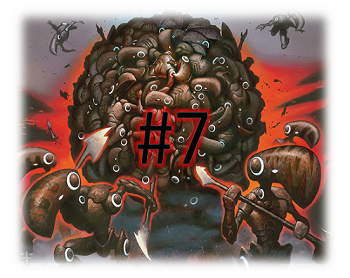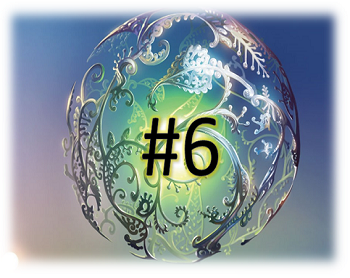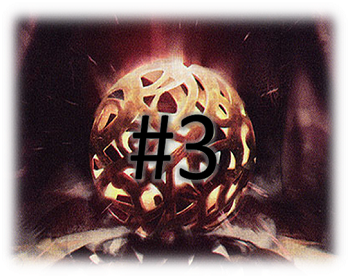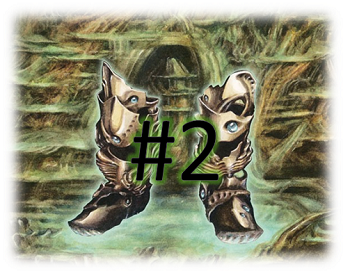Eat Your Heart Out, Keruga

(Troyan, Gutsy Explorer | Art by Jesper Ejsing)
I Got Five On It!
Welcome to Too-Specific Top 10, where if there isn’t a category to rank our pet card at the top of, we’ll just make one up! (Did you know that Submerge is the only blue creature removal spell you can play for free without exiling, discarding, or returning cards to your hand?)
A year or two ago, I was talking with a friend about cEDH, as I was just starting to get into it. As the conversation went on and I kept on peppering them with deck ideas that would be summarily rejected, they rather exasperatedly said, "Look, it's about access to colors, combos, and card draw." Thinking about it for a minute, I said, "Well then, could you make a good cEDH deck on the basic premise of having all five colors and ten cards in 'hand'?" They were dubious, but I pressed on with this nonsense to make the deck that I play in cEDH today, 5-Color 10-Card:
5c10c
View on ArchidektBuy this decklist from TCGplayer
View this decklist on Archidekt
I've talked a bit about the idea that built this deck before, but rarely about the actual construction of it. Obviously the challenge here is that if you're going to include Keruga, the Macrosage as your companion, that means that you're cutting out a good 90% of cEDH staples that make the format work, and probably cutting out more or less all of your interaction over the first two turns.
...Or does it?
From Force of Will to Brazen Borrower, there is no lack of ways to play spells that you can cast for free or that you can cast for less than their total mana value as Keruga sees it. And with access to all five colors, you can play all of them, resulting in an interaction package of 18 spells that you can cast in the deck for less than three (or just free).
Which brings us to the new commander we'll be talking about this week.
Troyan, Gutsy Explorer, like Keruga before him, cares about the mana value of spells that he's going to help cast. The difference? He wants to go even bigger.
Top 10 Simic Cards That Cost Five or More on the Stack, But Not in Reality
So I figure, if I can make a tier two cEDH deck that only has spells that cost three or more with five colors to work with, surely I can make a mid-powered Simic deck that only has spells that cost five or more, right?
Only, it's actually even harder than that. There's a trick I used rather extensively with Keruga that won't work with Troyan.
Split cards in all of their various formats have been around for decades now, so it's fairly common knowledge that their mana value is considered to be the total mana costs of both halves of the card put together. This is true for every facet of where cards can end up, except on the stack. There, when you cast the Petty Theft half of Brazen Borrower. It only has a mana cost of two, as advertised in the text box. The same is true for the more normal split cards such as Fire // Ice, Fuse cards like Wear // Tear, and Aftermath cards like Dusk // Dawn, in addition to Adventures.
That's right, they put a commander into the Adventure set that doesn't really work with Adventures.
So, with that crushing disappointment, on to the "real" five-mana cards.
Criteria: Cards within the Simic color identity that will have a mana value of five or more while on the stack but can be cast through another means that can cost less mana. As is tradition, all results are ordered by EDHREC score.
10. Junk Winder
(30,827 Inclusions, 2% of 1,488,091 Decks)
Junk Winder is my favorite kind of new powerhouse card: One that is only a powerhouse within its specific niche. If you're in a token deck, you can't do much better than a 5/6 for two mana that will routinely stun your opponent's permanents. If you're not, then there's no way you're going to find room for a seven mana 5/6 that might occasionally tap some things.
For our purposes? Neither Troyan nor Keruga care about tokens, so unless we found an extreme theme along the way, this one's probably a no go.
9. Misdirection
(34,305 Inclusions, 2% of 1,488,091 Decks)
Usually, the general makeup of building a low-power deck would mean that we wouldn't even be considering free spells like Misdirection. If the game's going slower, why bother with the card disadvantage that will have less targets to start with because less people will be playing interaction in the first place? Not so when it comes to building our five-mana-or-more version of Troyan! With us not doing anything at all for the first three to four turns of the game, we're going to need every single one of exactly these kinds of effects we can find. In other words, Misdirection is exactly the kind of card we're hoping to find on this list!
8. Thought Monitor
(41,646 Inclusions, 3% of 1,488,091 Decks)
Thought Monitor isn't quite as much of a slam dunk, but there is one consideration that might at least make it worth looking at: The ever-increasing amount of artifact lands that you can play in Magic: The Gathering.
Top 10 Simic Artifact Lands
Whelp, six out of 36 ain't gonna cut it, and five-mana artifacts aren't going to help soon enough. Next!
7. Thoughtcast
(47,076 Inclusions, 3% of 1,488,091 Decks)
I see that we're going to have a recurring issue here. Thoughtcast is a little easier on the artifact inclusions than Thought Monitor, but still not nearly enough.
6. Ghalta, Primal Hunger
(Helms 3,238 Decks, Rank #268; 60,769 Inclusions, 4% of 1,396,503 Decks)
Ghalta, however, seems a lot more promising! Sure, it's not gonna come down on turn three or anything, but who cares? A 12/12 trampler is a problem worth waiting for, and there are a ton of creatures that can come out at a reduced cost, as we'll see in the Honorable Mentions.
5. Dig Through Time
(95,765 Inclusions, 6% of 1,488,091 Decks)
And we've arrived. I almost didn't do this list when I saw the results, as there was a very similar bend in the top half from the list I did for Hidetsugu and Kairi. In short, when it comes to casting spells for less than they actually cost, it's difficult to do better than the blue Delve spells. Dig Through Time comes down at number two on that list, to be sure, but will still all too often get you two cards and a look at seven for two mana, which is undeniably a great rate. Now, in our five-mana version of Troyan, it's going to be a lot more difficult to fill the graveyard early than it is in the average deck, but there are still a lot of mundane ways of doing so:
Top 10 Simic Sacrifice for "Mana" Lands
- Evolving Wilds
- Myriad Landscape
- Terramorphic Expanse
- Misty Rainforest et al
- Fabled Passage
- Prismatic Vista
- Blighted Woodland
- Lotus Field
- Brokers Hideout et al
- Crystal Vein
Outside of the obvious $40 fetches, there are still a ton of other lands that sacrifice themselves early to grab a more mundane land from your deck. Evolving Wilds has been a precon staple for as long as Wizards has been making them, Myriad Landscape was always going to be a turn three mainstay of this deck, and you can't beat Misty Rainforest if you've got the pocketbook. That said, I've always disliked the idea of off-color fetches, so rather than spend a combined $300 dollars on a cEDH mana base for our silly arbitrary restriction of a Simic deck, I would instead suggest the likes of Fabled Passage, Prismatic Vista, Lotus Field, and Crystal Vein. There are also other lands further down this list that will get you to five mana a bit quicker while also ending up in the graveyard, most notably from the Havenwood Battleground and Saprazzan Skerry cycles. There are also what are sure to be the all-star lands of this deck in the Channel lands, most notably Boseiju, Who Endures, along with the Cycling lands you'll be able to discard early.
4. Treasure Cruise
(97,658 Inclusions, 7% of 1,488,091 Decks)
Once you've got all those lands in the graveyard, though, if we're being honest, the better thing to spend them on is probably Treasure Cruise. I heard tell once that three cards for one mana is pretty good.
3. Mulldrifter
(118,996 Inclusions, 8% of 1,488,091 Decks)
By that logic, then, three mana for two cards shouldn't be that great, but it turns out that creatures are good for other stuff too! While the now defunct Divination has never been all that impressive, if it triggered enter and dies triggers when it was cast, it would already be a lot better. Insert an ability to get onto the battlefield permanently for five, and there's a lot of things to like about Mulldrifter, even in a Troyan deck that really is just looking to use it as the plain old "pay three mana, get two cards".
2. The Great Henge
(136,294 Inclusions, 10% of 1,396,503 Decks)
The Great Henge is amazing in decks that have even a reasonably sized commander, but as you may have noticed, Troyan is a 1/3. That means that we're going to have to get our cost reduction for this card from other sources if we're looking to abuse the miles of text on it.
Thankfully, I know a guy.
Top 10 Simic Creatures with Mana Value Five or More That Can Reduce The Great Henge's Casting Cost to Less Than Five That Can Cost Less Than Five While on the Stack
- Ghalta, Primal Hunger
- Junk Winder
- Emrakul, the Promised End (technically possible, now that Battles exist)
- Metalwork Colossus
- Earthquake Dragon
- Sawtusk Demolisher
- Deep-Sea Kraken
- Ancient Stone Idol
- Impervious Greatwurm
- Octavia, Living Thesis
All righty then! It seems we have no lack of things that can come down early to get the price of The Great Henge a bit more manageable. Sure, we'd rather have that stuff in the command zone, but considering what we do have in the command zone is a guy that makes yet more mana, I think we're gonna be all right.
1. Force of Will
(164,081 Inclusions, 11% of 1,488,091 Decks)
The greatest free Counterspell ever printed meets our criteria, and even if it breaks the otherwise pretty reasonable pocket book price of our admittedly bad deck, we're still going to include it. The lolz alone make it worth the price of admission, and Urza knows we're going to have some bad stuff happen in the early turns while we have some blue spells stacked up in our hand.
Honorable Mentions
There are a lot of mechanics that make weird decks like Keruga and Troyan possible, so we would be doing ourselves a disservice not to jump into a few of the ones we haven't really covered yet.
Emerge
Emerge is a surprisingly deep mechanic out of Eldritch Moon. The general idea is you can sacrifice a creature with a high mana value (something we're gonna have plenty of, technically) to reduce a huge creature's mana value down to something more reasonable. Put simply, this is going to be the meat and potatoes of our late game in Troyan, and we're thankful for it. Especially Craterhoof Decimator of the Provinces.
Mutate
One that we wish was a little deeper (and less confusing) of a mechanic is Mutate, which will also be making us some wicked creatures in the mid-game, while tacking on some utility as well.
Foretell
While I've never been that crazy about Foretell outside of my love of Stoic Farmer, it does have a few decent picks that will work in this arbitrarily expensive deck, none moreso than Sage of the Beyond.
Miracle
Without dedicated top-deck manipulation, Miracle can get a little dicey. With that said, most of the effects we can play under our restrictions cost five mana at worst anyhow, so what do we have to lose?
All right, enough playing around, let's take a look at this weird list!
Eat Your Heart Out, Keruga
View on Archidekt
|
Buy this decklist from TCGplayer
View this decklist on Archidekt
The list feels clunky, as you might expect, but not so much that it feels bad for a mid-power deck. It's rare that you do anything of too much note on turns one and two, but with Troyan guaranteed to come down on turn three, you still feel like you've caught up to the table by turn four, casting haymakers into wide boards with no remorse. Combine that with the cheap and free interaction you seem to constantly have stacked up in your hand, and it's not hard to see the appeal of laying low early. It's not at all uncommon to untap with Troyan and cast a huge creature and an extra turn spell to catch up with the table, which is a really fun feeling against a table that assumed you were never going to amount to much after you went on a rant about how nothing in your deck costs less than five.
Nuts and Bolts
There always seems to be a bit of interest in how these lists are made (this seems like a good time to stress once again that they are based on EDHREC score, NOT my personal opinion…), and people are often surprised that I’m not using any special data or .json from EDHREC, but rather just muddling my way through with some Scryfall knowledge! For your enjoyment/research, here is this week’s Scryfall search.
What Do You Think?
I don't know that I've talked a whole lot about this here in my article series outright, but for each of my non-cEDH decks I own in paper, I have built them around an arbitrary restriction of some sort. I find that it makes deck-building more fun and unique while also keeping the power level of decks down without me feeling like I'm playing bad cards just to play bad cards.
With that said, I'm aware that I'm an extreme minority when it comes to this take on deck-building... Or am I?
And finally, what do you think of the Simic pairing of Troyan and Keruga? Do you like the idea of building a deck entirely out of technically expensive cards? Do you think Troyan is better as strictly an X commander?
Let us know in the comments, and we'll see you at the Ikea table that you can buy in installments, either physically or financially.











EDHREC Code of Conduct